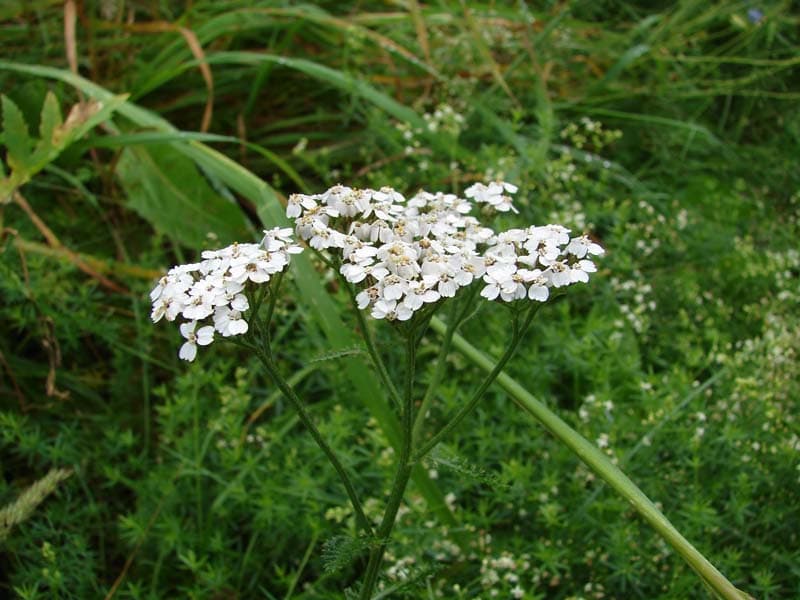Common Name: Yarrow
Latin Name: Achillea millefolium
Magical Name(s): Seven Year’s Love, Thousand Seal
Family: Asteraceae

Warning
Only use small doses. The skin can become sensitive to sunlight if you use too large doses. Avoid during pregnancy!
Description
Yarrow is a hardy, weedy perennial, grows 8-18 inches (20-45 cm), sometimes to 24 inches (60 cm), tall. If cultivated and fertilized, can grow to 5 feet.
It is identifiable in part by the finely divided leaves (millefolium = of a thousand leaves) and the erect flowering stalk with the white or reddish composite flowers that are arranged in panicled false umbels, and in part by its aromatic scent, which is released when the leaves and flowers are crushed.
Borne in large, flat, dense clusters 6 inches in diameter, the flowers are on top of the erect stems. Each flower head resembles a single flower but has five ray florets and a central disk. It blooms in summer to early fall. Seeds have small wings.
It has soft, grayish, feathery, ethereal-looking leaves. The flowers are usually white but hybrids of today come in lavenders, reds, lemon-yellow and pinks. Varieties: A tomentosa, A. filipendulina, A decolorans. The white blooming A. millefolium is the most cultivated for medicinal use.
Constituents
Sesquiterpene lactone – alpha-peroxyachifolid, rutin, tannins, coumarins, saponins, sterols, alkaloids.
In the 1950’s an alkaloid from the plant was found to have some ability to make blood clot faster. A volatile oil called azulene and related compounds have shown anti-inflammatory activity. Research from the 60’s attributes yarrow’s anti-spasmodic effect as a result of its flavonoids. The plant also has salicylic acid (aspirin) derivatives.
There has been very little research on yarrow’s medicinal properties. One study examining the effects of a three-herb mouthwash (yarrow, juniper, nettle) showed it to be ineffective in treating gum inflammation or the build-up of plaque.
Medicinal Use
Even though there have been no studies focused uniquely on yarrow and how it affects people, clinical experience (and in some cases animal or laboratory studies) support the use of yarrow for the following purposes:
Loss of appetite, digestive complaints, to increase urine flow, liver and gallbladder conditions, menstrual irregularities, menstrual cramps and pain, muscle spasms, inflammation, to fight infection, fever (brings temperature down by promoting perspiration), to reduce bleeding, wound healing.
Yarrow produces a feeling of peace and relaxation for women in the menopause, and is a tonic. Yarrow, either as a tea or as a bath additive, has proved helpful in allaying rheumatic pain and control of high blood pressure.
Magical Use
Magic uses include Courage, Love, Psychic Powers and Exorcism. The dried stalks are used to make I Ching sticks for divination. Burn it in divination incenses.
Cosmetic Use
The flower tops promote the digestion and act cleansing, diuretic and lower high blood pressure. Fresh leaves are haemostatic and are used as a bandage on wounds, for example from shaving. It’s also beneficial for the hands when used in lotions.
An infusion on Fennel, Yarrow, Marigold petals, Lady’s Mantle, Roman Chamomile, Comfrey or High Mallow is good for coarse, grooved hands.
Fresh Yarrow leaves stop bleeding. A punch of dried leaves, moistened with honey also works.
Culinary Use
Cultivation
Hardy to zone 2, it prefers rich well drained soil, but will thrive on wasteland also. They do like full sun, shade tends to lead to leggy plants with faded color, but they dry just as well if you use them for crafting.
It flourishes in a sunny and warm habitat, and is frequently found in meadows and along roadsides, as well as on dry, sunny slopes in Europe and Asia.
Harvest
Other Recipes
Fun Facts
Yarrow is a very old herb. It has been said that fossils of the herb were identified in Neanderthal burial caves.
Legend has it that yarrow (Achillea millefolium) was named after Achilles, the Greek mythical figure who used it to stop the bleeding wounds of his soldiers.
Folklore calls this herb Soldier’s Woundwort as it was used to stop bleeding. It was used in ancient China , in field hospitals at Troy , the Trojan war (some 3,000 years ago) and the American Civil War.
It’s been used to preserve wine, as a spice in aquavit and instead of Hops in beer production to increase the taste and strength of the beer. It’s also been mixed into snuff.
